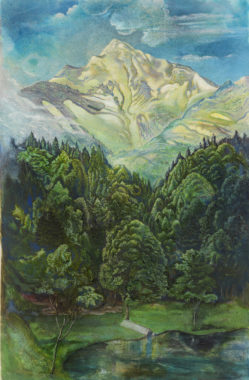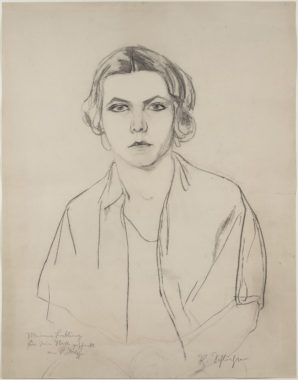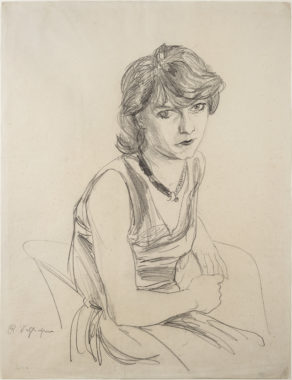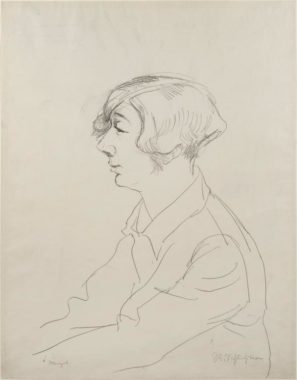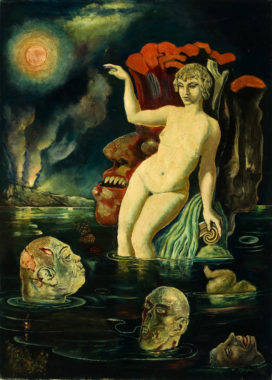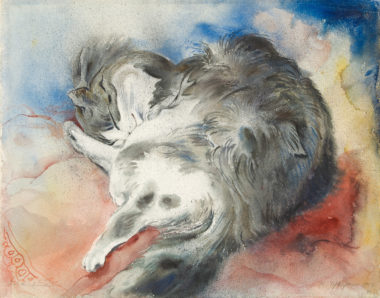Schlichter, Rudolf
Sold Artworks
Biography
Rudolf Schlichter
1890 Calw – 1955 Munich
Rudolf Schlichter studied painting under Hans Thoma and Wilhelm Trübner at the Karlsruhe Academy of Art from 1910 to 1916. He was a free-spirited student with an appetite for the bizarre and unconventional. During his time at the Academy he frequented bohemian circles and, initiated by a fellow student, mined the sordid secrets of a shadowy half-world. This provided the perfect escape from the bourgeois upbringing that he despised and allowed him to live out his erotic obsessions.
Like many other artists of his generation Schlichter suffered from the severe physical and emotional effects of the First World War, although he succeeded in securing early release from service by going on hunger strike. Reflecting on the impact of the war, he was convinced that the collapse of the German Kaiserreich was not a catastrophe but instead, an opportunity for a new start which heralded radical social and artistic change. In 1919, he moved to Berlin where he joined the Communist party and the November Group, a revolutionary group of radical artists. Fellow members were George Grosz, John Heartfield and Otto Dix. Schlichter soon advanced to be one of the leading artists of the young Weimar Republic, if not the most controversial.
Schlichter was active as a painter and as a writer. In 1920s Berlin he led a stimulating but chaotic life divided between the red light milieu and intellectualist circles. Members of his own politically active circle were left-wing writers like Bertold Brecht, Alfred Döblin and Carl Zuckmayer and later on, the radical nationalist writer Ernst Jünger.
Schlichter’s restlessness is reflected in his work. His social and political awareness led him to explore a range of artistic styles from Dada and Futurism to Verism, ultimately arriving at Neue Sachlichkeit. He became one of the leading figures of the movement and enjoyed considerable success with his psychologically incisive portraits. An acute observer, he produced an acerbic portrayal of urban life, depicting his models on the street and in cafes and saloon bars, where he mingled immaculately coiffed, moustachioed philistines with floozies, prostitutes, pimps and the marginalised.
Schlichter’s meeting with the actress Elfriede Elisabeth Köhler in 1927 was of great significance for his emotional and artistic development. They were married in 1929. Known as Speedy after a popular contemporary film, she was his muse, angel and temptress, mannequin and life model – the Madonna and domina that he immortalized in hundreds of drawings, watercolours and gouaches. But she was also a catalyst for radical change in his attitude. Influenced by her, he turned to Catholicism and embraced nationalist ideas. The shift prompted him to abandon the hubbub of big-city life in Berlin and move to the quiet Swabian bishopric of Rottenburg am Neckar in 1932. Hopes of a fresh start went hand in hand with a new interest in the realistic portrayal of landscape.
When the Nazis consolidated their power in 1933, creating a one-party state with Hitler as Chancellor, Schlichter was rapidly targeted by the Reichskammer der Bildenden Künste, from which he was temporarily excluded. In 1936 he and his wife settled in Stuttgart. Over the next few years his works were purged from German museums. In 1937 they were seized as ‘degenerate’ art and shown at the defamatory exhibitions staged in numerous cities throughout Germany. In 1938, he was briefly arrested on grounds of apparent unnationalsozialistische Lebensführung. In 1939 Schlichter and his wife moved to Munich. In the same year he was banned from exhibiting. Both his studio and their apartment were destroyed by Allied bombing in 1942.
At the end of World War II Schlichter entered a new phase of creative activity, engaging intensively with the traumatic events of the Third Reich. He began to produce apocalyptic visions of a surreal world populated with nightmarish hybrid figures and fantastical creatures to voice his critique of the modern technological world. He saw technological advance as a threat to European culture. His representational approach was influenced by the pictorial language of French Surrealism, setting his work apart from the trend towards abstraction in the post-war period. He exhibited widely in Germany and his work was lauded at the Venice Biennale in 1948 and 1954. He died from cancer in Munich in 1955.
PDF Download